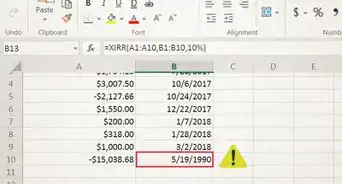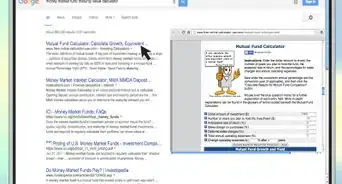This article was co-authored by Chad Seegers, CRPC®. Chad Seegers is a Certified Retirement Planning Counselor (CRPC®) for Insight Wealth Strategies, LLC in Houston, Texas. Prior to this, Chad worked as a Private Wealth Advisor for Sagemark Consulting for over ten years, where he became a select member of their Private Wealth Services. With over 15 years of experience, Chad specializes in retirement planning for oil and gas employees and executives as well as estate and investment strategies. Chad is a supporting member of the World Affairs Council and an emerging leader with the Global Independence Center (GIC).
There are 16 references cited in this article, which can be found at the bottom of the page.
wikiHow marks an article as reader-approved once it receives enough positive feedback. This article received 13 testimonials and 80% of readers who voted found it helpful, earning it our reader-approved status.
This article has been viewed 3,063,098 times.
Contrary to popular belief, the stock market is not just for rich people. Investing is one of the best ways for anyone to create wealth and become financially independent. A strategy of investing small amounts continuously can eventually result in what is referred to as the snowball effect, in which small amounts gain in size and momentum and ultimately lead to exponential growth. To accomplish this feat, you must implement a proper strategy and stay patient, disciplined, and diligent. These instructions will help you get started in making small but smart investments.
Steps
Getting Ready to Invest
-
1Ensure investing is right for you. Investing in the stock market involves risk, and this includes the risk of permanently losing money. Before investing, always ensure you have your basic financial needs taken care of in the event of a job loss or catastrophic event.[1]
- Make sure you have 3 to 6 months of your income readily available in a savings account. This ensures that if you quickly need money, you will not need to rely on selling your stocks. Even relatively "safe" stocks can fluctuate dramatically over time, and there is always a probability your stock could be below what you bought it for when you need cash.
- Ensure your insurance needs are met. Before allocating a portion of your monthly income to investing, make sure you own proper insurance on your assets, as well as on your health.
- Remember to never depend on investment money to cover any catastrophic event, as investments do fluctuate over time. For example, if your savings were invested in the stock market in 2008, and you also needed to spend 6 months off work due to an illness, you would have been forced to sell your stocks at a potential 50% loss due to the market crash at the time. By having proper savings and insurance, your basic needs are always covered regardless of stock market volatility.
-
2Choose the appropriate type of account. Depending on your investment needs, there are several different types of accounts you may want to consider opening. Each of these accounts represents a vehicle in which to hold your investments.[2]
- A taxable account refers to an account in which all investment income earned within the account is taxed in the year it was received. Therefore, if you received any interest or dividend payments, or if you sell the stock for a profit, you will need to pay the appropriate taxes. As well, money is available without penalty in these accounts, as opposed to investments in tax deferred accounts. [3] [4]
- A traditional Individual Retirement Account (IRA) allows for tax-deductible contributions but limits how much you can contribute. An IRA doesn't allow you to withdraw funds until you reach retirement age (unless you're willing to pay a penalty). You would be required to start withdrawing funds by age 70. Those withdrawals will be taxed. The benefit to the IRA is that all investments in the account can grow and compound tax free. If, for example, you have $1000 invested in a stock, and receive a 5% ($50 per year) in dividends, that $50 can be reinvested in full, rather than less due to taxes. This means the next year, you will earn 5% on $1050. The trade-off is less access to money due to the penalty for early withdrawal.[5]
- Roth Individual Retirement Accounts do not allow for tax-deductible contributions but do allow for tax-free withdrawals in retirement. Roth IRAs do not require you to make withdrawals by a certain age, making them a good way to transfer wealth to heirs. [6]
- Any of these can be effective vehicles for investing. Spend some time learning more about your options before making a decision.
Advertisement -
3Implement dollar cost averaging. While this may sound complex, dollar cost averaging simply refers to the fact that -- by investing the same amount each month -- your average purchase price will reflect the average share price over time. Dollar cost averaging reduces risk due to the fact that by investing small sums on regular intervals, you reduce your odds of accidentally investing before a large downturn. It is a main reason why you should set up a regular schedule of monthly investing. In addition, it can also work to reduce costs, since when shares drop, your same monthly investment will purchase more of the lower cost shares.
- When you invest money in a stock, you purchase shares for a particular price. If you can spend $500 per month, and the stock you like costs $5 per share, you can afford 100 shares.
- By putting a fixed amount of money into a stock each month ($500 for example), you can lower the price you pay for your shares, and thereby make more money when the stock goes up, due to a lower cost.
- This occurs because when the price of the shares drops, your monthly $500 will be able to purchase more shares, and when the price rises, your monthly $500 will purchase less. The end result is your average purchase price will lower over time.
- It is important to note that the opposite is also true -- if shares are constantly rising, your regular contribution will buy fewer and fewer shares, raising your average purchase price over time. However, your shares will also be raising in price so you will still profit. The key is to have a disciplined approach of investing at regular intervals, regardless of price, and avoid "timing the market".
- After a stock market crash, and before the stock market recovers (recoveries rise slower than crashes), consider increasing your 401k contribution by a few percent. This way you will take advantage of low prices and not have to do anything else but stop the extra contribution a couple of years later.
- At the same time, your frequent, smaller contributions ensure that no relatively large sum is invested before a market downturn, thereby reducing risk.
-
4Explore compounding interest. Compounding is an essential concept in investing, and refers to a stock (or any asset) generating earnings based on its reinvested earnings.[7]
- This is best explained through an example. Assume you invest $1000 in a stock in one year, and that stock pays a dividend of 5% each year. At the end of year one, you will have $1050. In year two, the stock will pay the same 5%, but now the 5% will be based on the $1050 you have. As a result, you will receive $52.50 in dividends, as opposed to $50 in the first year.
- Over time, this can produce huge growth. If you simply let that $1000 sit in account earning a 5% dividend, over 40 years, it would be worth over $7000 in 40 years. If you contribute an additional $1000 each year, it would be worth $133,000 in 40 years. If you started contributing $500 per month in year two, it would be worth nearly $800,000 after 40 years.
- Keep in mind since this is an example, we assumed the value of the stock and the dividend stayed constant. In reality, it would likely increase or decrease which could result in substantially more or less money after 40 years.
Choosing Good Investments
-
1Avoid concentration in a few stocks. The concept of not having all your eggs in one basket is key in investing. To start, your focus should be on getting broad diversification, or having your money spread out over many different stocks.[8]
- Just buying a single stock exposes you to to the risk of that stock losing significant value. If you buy many stocks over many different industries, this risk can be reduced.
- For example, if the price of oil falls and your oil stock drops by 20%, it is possible that your retail stock will increase in value due to customers having more spending money as a result of lower gas prices. Your information technology stock may stay flat. The end result is your portfolio sees less downside
- One good way to gain diversification is to invest in an product that provides this diversification for you. This can include mutual funds, or ETF's.[9] Due to their instant diversification, these provide a good option for beginner investors.[10] [11]
-
2Explore investment options. There are many different types of investment options. However, since this article focuses on the stock market, there are three primary ways to gain stock market exposure.
- Consider an ETF index fund. An exchange-traded index fund is a passive portfolio of stocks and/or bonds that aim to accomplish a set of objectives. Often, this objective is to track some broader index (like the S&P 500 or the NASDAQ). If you buy an ETF that tracks the S&P 500 for example, you are literally purchasing stock in 500 companies, which provides enormous diversification. One of the benefits of ETFs are their low fees. Management of these funds is minimal, so the client doesn't pay much for their service.[12]
- Consider an actively managed mutual fund. A actively managed mutual fund is a pool of money from a group of investors that is used to purchase a group of stocks or bonds, according to some strategy or objective. One of the benefits of mutual funds is professional management. These funds are overseen by professional investors who invest your money in a diversified way and will respond to changes in the market (as noted above). This is the key difference between mutual funds and ETF's -- mutual funds have managers actively picking stocks according to a strategy, whereas ETF's simply track an index. One of the downsides is that they tend to be more expensive than owning an ETF, because you pay an extra cost for the more active management service.[13] [14]
- Consider investing in individual stocks. If you have the time, knowledge, and interest to research stocks, they can provide significant return. Be advised that unlike mutual funds or ETF's which are highly diversified, your individual portfolio will likely be less diversified and therefore higher risk. To reduce this risk, refrain from investing more than 20% of your portfolio in one stock. This provides some of the diversification benefit that mutual funds or ETF's provide.
-
3Find a broker or mutual fund company that meets your needs. Utilize a brokerage or mutual fund firm that will make investments on your behalf. You will want to focus on both cost and value of the services the broker will provide you. [15]
- For example, there are types of accounts that allow you to deposit money and make purchases with very low commissions. This may be perfect for someone who already knows how they want to invest their money. [16]
- If you need professional advice regarding investments, you may need to settle for a place with higher commissions in return for a higher level of customer service. [17]
- Given the large number of discount brokerage firms available, you should be able to find a place that charges low commissions while meeting your customer-service needs.
- Each brokerage house has different pricing plans. Pay close attention to the details regarding the products you plan to use most often.
-
4Open an account. You fill out a form containing personal information that will be used in placing your orders and paying your taxes. In addition, you will transfer the money into the account you will use to make your first investments.
Focusing on the Future
-
1Be patient. The number-one obstacle that prevents investors from seeing the huge effects of compounding mentioned earlier is lack of patience. Indeed, it is difficult to watch a small balance grow slowly and, in some instances, lose money in the short term. [18]
- Try to remind yourself that you are playing a long game. The lack of immediate, large profits should not be taken as a sign of failure. For example, if you a purchase a stock, you can expect to see it fluctuate between profit and loss. Often, a stock will fall before it rises. Remember that you are buying a piece of a concrete business, and in the same way you would not be discouraged if the value of a gas station you owned declined over the course of a week or a month, you should not be discouraged if the value of your stock fluctuates. Focus on the companies earnings over time to gauge its success or failure, and the stock will follow.
-
2Keep up the pace. Concentrate on the pace of your contributions. Stick to the amount and frequency you decided upon earlier, and let your investment build up slowly. [19]
- You should relish low prices! Dollar-cost-averaging into the market is a tried and true strategy for generating wealth over the long run. [20] Furthermore, the less expensive the stock prices are today, the more upside you can expect tomorrow.
-
3Stay informed and look ahead. In this day and age, with technology that can provide you with the information you seek in an instant, it is tough to look several years to the future while monitoring your investment balances. Those that do, however, will slowly build their snowball until it builds up speed and helps them achieve their financial goals.
-
4Stay the course. The second biggest obstacle to achieving compounding is the temptation to change your strategy by chasing fast returns from investments with recent big gains or selling investments with recent losses. That's actually the opposite of what most really successful investors do. [21]
- In other words, don’t chase returns. Investments that are experiencing very high returns can just as quickly turn around and go down. "Chasing returns" can often be a disaster. [22] Stick to your original strategy, assuming it was well thought out to begin with.
- Stay put and don’t repeatedly enter and exit the market. History shows that being out of the market on the four or five biggest up-days in each calendar year can be the difference between making and losing money. You won't recognize those days until they've already passed.
- Avoid timing the market. For example, you may be tempted to sell when you feel the market may decline, or avoid investing because you feel the economy is in a recession. Research has proven the most effective approach is to simply invest at a steady pace and use the dollar cost averaging strategy discussed above.
- Studies have found that people who simply dollar cost average and stay invested do far better then people who try to time the market, invest a lump sum every year on new years, or who avoid stocks. The reason for this is that it takes a decade or so to learn the many pitfalls in investing in stocks, like the emotion that goes with a bull market, exaggerated information, sales groups that are paid to sell and tend to bend the information to look to rosy and just plain fraud. Many brokers will not tell you that 99.9999% of all companies go bankrupt over time, so mutual funds and dollar cost averaging avoids all the bad companies that are removed without you have to do any homework or lose any money. [23]
What Are Common Mistakes When Starting To Invest?
Warnings
- Be prepared to wait a while before you see a significant return on your investments. Small, low-risk investments take a while to pay off.⧼thumbs_response⧽
- Even the safest investment comes with risk. Don't invest more than you can afford to lose.⧼thumbs_response⧽
References
- ↑ Chad Seegers, CRPC®. Certified Retirement Planning Counselor. Expert Interview. 16 July 2020.
- ↑ Chad Seegers, CRPC®. Certified Retirement Planning Counselor. Expert Interview. 16 July 2020.
- ↑ http://www.moneycrashers.com/need-taxable-brokerage-account-ira-401k-retirement/
- ↑ http://www.investopedia.com/terms/b/brokerageaccount.asp
- ↑ http://www.moneycrashers.com/what-is-a-traditional-ira-restrictions-and-benefits/
- ↑ http://www.rothira.com/traditional-ira-vs-roth-ira
- ↑ Chad Seegers, CRPC®. Certified Retirement Planning Counselor. Expert Interview. 16 July 2020.
- ↑ http://www.investopedia.com/terms/u/unsystematicrisk.asp
- ↑ Chad Seegers, CRPC®. Certified Retirement Planning Counselor. Expert Interview. 16 July 2020.
- ↑ http://www.investopedia.com/terms/u/unsystematicrisk.asp
- ↑ http://www.morningstar.com/InvGlossary/minimum_investments.aspx
- ↑ http://www.nasdaq.com/etfs/what-are-ETFs.aspx
- ↑ http://money.cnn.com/magazines/moneymag/money101/lesson6/index2.htm
- ↑ http://guides.wsj.com/personal-finance/investing/what-is-a-mutual-fund/
- ↑ http://www.investopedia.com/articles/stocks/08/fees-commission-value.asp
- ↑ http://www.investopedia.com/terms/d/discountbroker.asp
- ↑ http://www.investopedia.com/articles/stocks/08/fees-commission-value.asp
- ↑ http://www.telegraph.co.uk/finance/personalfinance/investing/shares/9529257/Investing-why-it-can-pay-to-be-patient.html
- ↑ http://zenhabits.net/bank/
- ↑ http://www.morningstar.com/InvGlossary/minimum_investments.aspx
- ↑ http://www.nasdaq.com/article/dont-chase-returns-with-your-retirement-account-cm348303
- ↑ http://dailyreckoning.com/dont-chase-returns-2015/
- ↑ http://www.telegraph.co.uk/finance/personalfinance/investing/shares/9529257/Investing-why-it-can-pay-to-be-patient.html
About This Article
To invest small amounts of money wisely, start by opening an account to hold your investments. Next, find a broker or mutual fund company that meets your needs to help you navigate the stock market and explore your investment options. If you want to invest in individual stocks, choose several different stocks and invest a small amount of money into each of them. Avoid concentrating your money in just one or two stocks to prevent any major losses! To learn more about monitoring your stock and choosing wise strategies for the future, read on!











































































